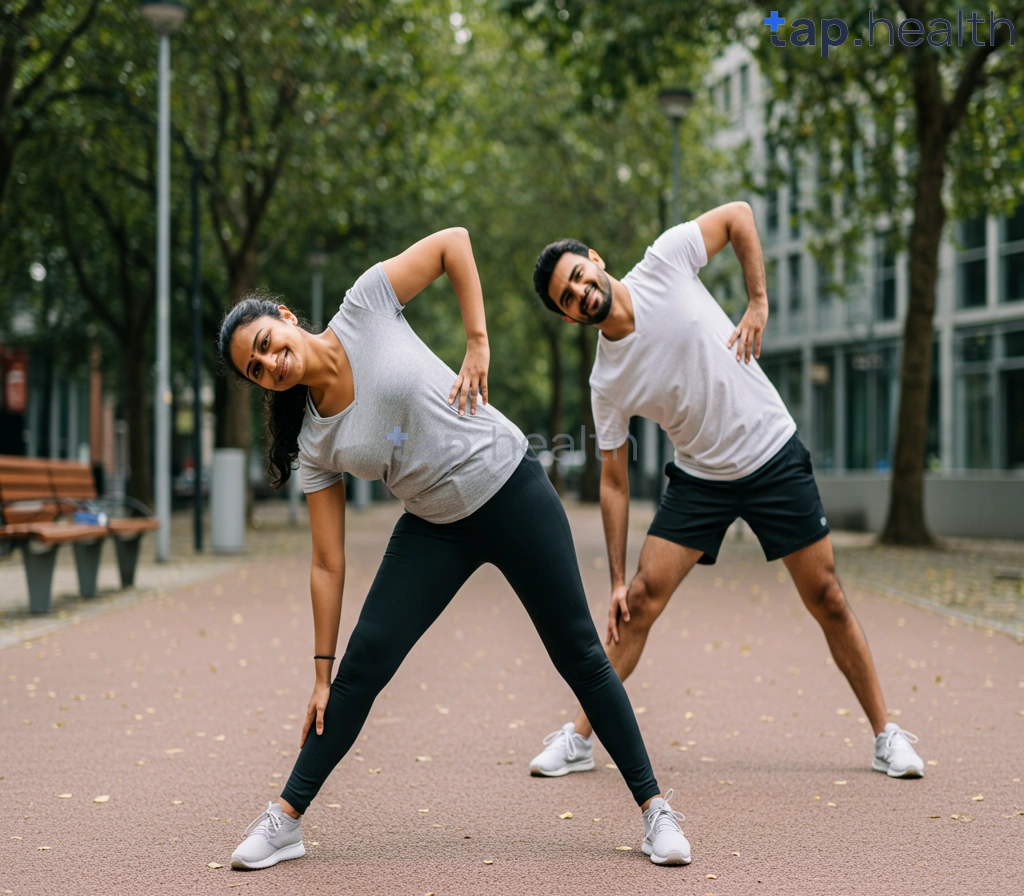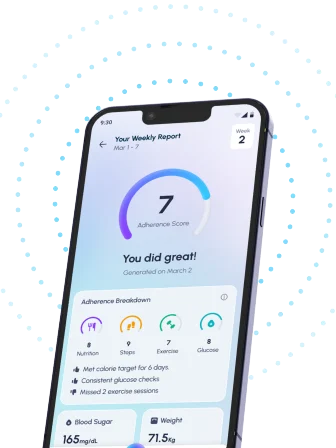Table of Contents
- 15-Minute Diabetes-Friendly Back Exercises
- Best Back Exercises for Diabetics: A Daily Guide
- Safe & Effective Back Stretches for Diabetes Management
- Combat Back Pain: Diabetes-Friendly Exercise Routine
- Improve Posture & Reduce Pain: Diabetic-Safe Back Exercises
- Frequently Asked Questions
- References
Living with diabetes often means paying extra attention to your overall health, and that includes your back! Back pain is incredibly common, but finding safe and effective exercises can be tricky when you have diabetes. That’s why we’ve created this Diabetes-Friendly Back Exercises: 15-Minute Daily Routine, designed to help you strengthen your back, improve posture, and manage pain – all within a short, manageable timeframe. No special equipment is needed, making it perfect for incorporating into your daily life. Let’s get started on your path to a healthier, happier back!
15-Minute Diabetes-Friendly Back Exercises
Maintaining a healthy back is crucial, especially for individuals with diabetes. Nearly 15% of diabetics experience foot ulcers in their lifetime, often leading to high amputation risks. Protecting your lower back through proper exercise can help improve posture, reduce strain, and indirectly support foot health by promoting better balance and reducing the risk of falls. This 15-minute routine focuses on gentle, effective movements suitable for individuals in Indian and tropical climates, where heat and humidity can impact exercise tolerance.
Warm-up (2 minutes)
Begin with gentle stretches like arm circles, leg swings, and torso twists. Remember to stay hydrated, especially in hot and humid conditions common in India and other tropical regions. Listen to your body and avoid any movements causing pain.
Exercises (10 minutes)
* **Cat-Cow Pose (2 minutes):** This gentle stretch improves spinal mobility and flexibility.
* **Pelvic Tilts (2 minutes):** Strengthen your lower back and abdominal muscles, crucial for core support.
* **Knee-to-Chest Stretch (2 minutes):** Alleviates lower back tension and improves hip flexibility.
* **Spinal Rotation (2 minutes):** Gently rotate your torso to improve spinal mobility and reduce stiffness. Be mindful of any existing back pain and adjust accordingly.
* **Bridge Pose (2 minutes):** This strengthens your glutes and hamstrings, supporting lower back stability.
Cool-down (3 minutes)
End with gentle stretches holding each for 30 seconds. Focus on breathing deeply and relaxing your muscles.
Remember to consult your doctor or a qualified physiotherapist before starting any new exercise routine, especially if you have diabetes or other health conditions. This routine is designed to be gentle and accessible; adapt it to your individual fitness level. Prioritize consistent, manageable exercise over intense workouts. Maintaining a healthy weight is also vital in diabetes management, and regular exercise contributes significantly to this goal. Staying active can help reduce your risk of complications, such as the development of foot ulcers. To learn more about protecting your feet, check out Top 5 Foot Care Tips for Diabetics | Easy Steps to Healthy Feet. Scheduling this routine into your daily life, along with other healthy habits, is key for long-term back health and overall well-being. For more tips on overall diabetes management, see our guide on 10 Proven Tips for Effective Diabetes Management.
Best Back Exercises for Diabetics: A Daily Guide
Managing diabetes requires a holistic approach, including regular exercise. A strong back is crucial for maintaining good posture and preventing injuries, especially important for those managing blood sugar levels. This 15-minute routine focuses on low-impact exercises suitable for individuals in Indian and tropical climates, mindful of potential heat and humidity. Remember to consult your doctor before starting any new exercise program.
Warm-up (2 minutes)
Begin with gentle stretches like arm circles, leg swings, and torso twists. This prepares your muscles for the workout and helps prevent injuries. Staying hydrated is crucial, especially in warmer climates, so keep a water bottle handy.
Exercises (10 minutes)
* Cat-Cow Pose: This yoga pose gently stretches and strengthens the back muscles. Perform 5-10 repetitions.
* Bridge Pose: This strengthens the glutes and lower back. Hold for 10-15 seconds, repeating 8-10 times. Focus on controlled movements to avoid strain.
* Plank: A great core exercise that also engages the back muscles. Start with 30-second holds, gradually increasing duration as you gain strength. Remember proper form to maximize benefits and avoid injury.
* Back Extensions: Lie on your stomach and gently lift your upper body, engaging your back muscles. Repeat 10-12 times.
Cool-down (3 minutes)
End with gentle stretches, focusing on the back and shoulders. Deep breathing exercises can help regulate blood sugar and promote relaxation.
Important Note: Maintain a balanced diet alongside this exercise routine. While carbohydrate intake varies depending on individual needs, a general guideline suggests 45–60 grams of carbs per meal for many with diabetes. Always consult with your doctor or a registered dietitian to determine the best dietary plan for your specific needs. This routine is a suggestion; adjust the intensity and duration based on your fitness level. Remember to listen to your body and stop if you experience any pain. Stay consistent, and you’ll see improvements in your back strength and overall well-being! For more information on the importance of exercise for diabetes management, see our article on Why Regular Exercise is Essential for Diabetes Management. And remember that a healthy diet plays a crucial role; check out our guide on 20 Best Foods for People with Diabetes – Tap Health for helpful tips.
Safe & Effective Back Stretches for Diabetes Management
Managing diabetes often involves focusing on overall health, and that includes maintaining a strong and flexible back. Back pain is common, particularly among the 61% of people with diabetes aged between 20-64 years, and even more so in the 39% aged 65+. Strengthening your back can improve posture, reduce pain, and help with daily activities, especially crucial in hot and humid climates common in Indian and tropical countries.
Gentle Back Stretches for a 15-Minute Routine
This routine focuses on stretches suitable for individuals with diabetes, considering potential limitations due to neuropathy or other complications. Remember to consult your doctor before starting any new exercise program.
* Knee-to-Chest Stretch: Lie on your back, knees bent. Gently pull one knee towards your chest, holding for 20 seconds. Repeat with the other leg. This helps relieve lower back tension.
* Spinal Twist: Lie on your back, knees bent. Extend your arms out to the sides. Gently drop both knees to one side, keeping your shoulders flat on the floor. Hold for 20 seconds and repeat on the other side. This improves spinal mobility.
* Cat-Cow Stretch: Start on your hands and knees. Inhale, dropping your belly towards the floor and arching your back (cow pose). Exhale, rounding your spine towards the ceiling (cat pose). Repeat 5-10 times. This improves flexibility and strengthens core muscles supporting the back.
* Child’s Pose: Kneel on the floor, big toes touching. Sit back on your heels (as best as you can) and fold forward, resting your forehead on the floor. Extend your arms forward. Hold for 30 seconds. This gentle stretch relieves stress on the back.
Remember to hydrate properly before, during, and after your routine, especially important in warmer climates. Listen to your body and stop if you feel any sharp pain. Managing stress is also important for overall health and can help with pain management; check out our article on Effective Stress Management Tips for Better Diabetes Control for helpful advice.
Maintaining Your Back Health in Tropical Climates
In Indian and tropical countries, the heat and humidity can exacerbate back pain. Staying hydrated is crucial to prevent muscle cramps and stiffness. Consider practicing these stretches in a cool, well-ventilated area during the cooler parts of the day. Regular, gentle exercise like this can significantly improve your quality of life. Start small, be consistent, and consult your doctor for personalized guidance. For more comprehensive tips on managing your diabetes, see our guide on 10 Proven Tips to Effectively Manage Diabetes.
Combat Back Pain: Diabetes-Friendly Exercise Routine
Back pain is a common problem, often exacerbated by conditions like diabetes. The global economic burden of diabetes, estimated at $760 billion annually, highlights the importance of preventative healthcare, including managing associated complications. This 15-minute daily routine focuses on gentle exercises safe for individuals with diabetes, helping to alleviate back pain and improve overall well-being. Remember to consult your doctor before starting any new exercise program.
Gentle Back Stretches for Diabetes
This routine emphasizes low-impact movements, crucial for individuals with diabetes who may have nerve damage or circulation issues. Start with simple stretches like cat-cow poses, gently arching and rounding your spine. Focus on controlled movements and deep breathing. Incorporate seated twists, carefully rotating your torso while maintaining good posture. These exercises improve flexibility and reduce stiffness, common in individuals with diabetes and those living in hot and humid climates prevalent in many Indian and tropical countries.
Strengthening Exercises
Next, include exercises that strengthen your core muscles, crucial for supporting your back. Plank variations, holding for shorter intervals initially, are excellent for engaging your abdominal and back muscles. Bridge poses, performed slowly and carefully, also help strengthen the lower back. Remember to listen to your body and stop if you feel any sharp pain. Maintaining a healthy weight is also crucial in managing diabetes and reducing back strain. For more information on preventing long-term complications, check out our guide on How to Prevent Long-Term Complications of Diabetes: Easy Tips.
Cooling Down and Mindfulness
Finish your routine with gentle stretches, focusing on releasing tension in your back and neck. Deep, conscious breathing helps to relax the muscles and reduces stress, a key aspect of managing diabetes. This routine, adapted to suit the warmer climates of India and other tropical regions, can be performed in the early morning or evening, providing a significant boost to your overall health. Consistency is key; even 15 minutes a day can make a significant difference in managing your back pain and overall health. Regular exercise, combined with a healthy diet and regular medical check-ups, is vital for managing diabetes effectively and improving your quality of life. If you’re interested in learning more about reversing diabetes, How to Reverse Diabetes Permanently offers valuable insights.
Improve Posture & Reduce Pain: Diabetic-Safe Back Exercises
Why Focus on Back Exercises with Diabetes?
Maintaining a healthy back is crucial, especially if you have diabetes. Poor posture and back pain are common, and studies show a strong link between diabetes and an increased risk of sleep disorders, including sleep apnea – a condition exacerbated by poor spinal alignment. This 70% increased risk highlights the importance of proactive back care. Strengthening your back muscles improves posture, reduces pain, and can contribute to better sleep quality, potentially mitigating some of the sleep-related complications associated with diabetes. Managing your diabetes effectively is also key, and you can learn more about safe and effective dietary supplements for diabetes care to support your overall health.
A 15-Minute Daily Routine for a Healthier Back
This routine focuses on gentle, effective exercises suitable for individuals with diabetes in hot and humid climates like those found across India and other tropical countries. Remember to consult your doctor or physical therapist before starting any new exercise program. Always stay hydrated, especially in warmer weather. These exercises can be adapted for different fitness levels, making them suitable for a wide range of individuals, including seniors. For more information on home workouts for seniors, check out our guide to safe and effective exercises for active aging.
Exercises to Include:
* Cat-Cow Stretch: A gentle warm-up that improves spinal mobility.
* Knee-to-Chest Stretch: Relaxes lower back muscles and improves flexibility.
* Spinal Twist: Improves mobility and releases tension in the back.
* Bridge Pose: Strengthens glutes and hamstrings, supporting lower back health.
* Plank (modified): Builds core strength, improving posture and reducing back pain. Start with shorter holds if needed.
Important Considerations for Tropical Climates:
* Timing: Avoid exercising during the hottest part of the day. Early mornings or evenings are ideal.
* Hydration: Drink plenty of water before, during, and after your workout.
* Clothing: Wear loose, breathable clothing to stay cool and comfortable.
Remember consistency is key. Even 15 minutes a day can make a significant difference in your back health and overall well-being. Prioritize your health and start building a stronger, healthier back today!
Frequently Asked Questions on Diabetes-Friendly Back Exercises | 15-Minute Daily Routine
Q1. What are these 15-minute back exercises all about?
These exercises are designed to gently improve posture, reduce back pain, and build core strength, all while being safe and suitable for people with diabetes, especially in hot and humid weather. The routines focus on low-impact movements like stretches and poses.
Q2. What kind of exercises are included in the routine?
The routines include gentle exercises such as cat-cow pose, pelvic tilts, knee-to-chest stretches, spinal rotations, and bridge pose. A warm-up and cool-down are also part of each session.
Q3. Are these exercises safe for people with diabetes?
While these exercises are designed to be gentle and safe, it is crucial to consult your doctor or physical therapist before starting any new exercise program, especially if you have diabetes or other health conditions. They can help you determine if these routines are appropriate for your specific needs and health status.
Q4. What are the benefits beyond back health?
Stronger core muscles improve balance, which helps reduce the risk of falls. Improved posture and balance indirectly benefit foot health, an important consideration for people with diabetes.
Q5. What else should I keep in mind when doing these exercises?
Remember to stay well-hydrated, especially in warm climates. Maintaining a healthy weight is also important for overall health and managing diabetes. The provided links offer additional resources on diabetes management and foot care.
References
- A Practical Guide to Integrated Type 2 Diabetes Care: https://www.hse.ie/eng/services/list/2/primarycare/east-coast-diabetes-service/management-of-type-2-diabetes/diabetes-and-pregnancy/icgp-guide-to-integrated-type-2.pdf
- What is Diabetes: https://www.medschool.lsuhsc.edu/genetics/docs/DIABETES.pdf




